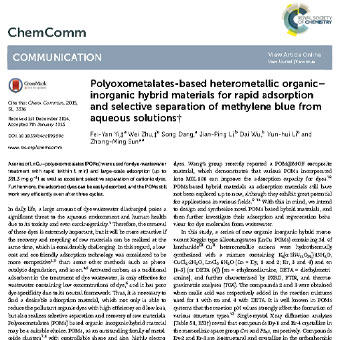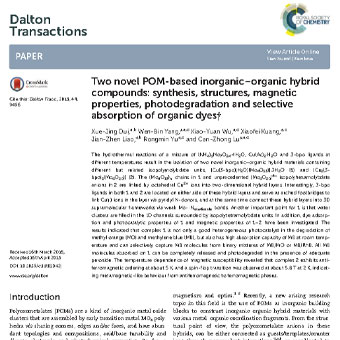عنوان فارسی مقاله: مواد هیبریدی آلی- غیر آلی هترومتالیک مبتنی بر پلی اگزومتالات برای جذب سریع و تفکیک انتخابی متیلن بلو از محلولهای آبی
چکیده
سریهای LnCu- پلی اکسومتالات ها (POM ها) برای تصفیه رنگ- فاضلاب با جذب سریع (در طی ۱ دقیقه) و بزرگ مقیاس (بیش از ۳۹۱۳ میلی گرم بر گرم) علاوه بر تفکیک انتخابی عالی رنگهای کاتیونی استفاده شدند. به علاوه، رنگهای جذب شده به راحتی جذب میشوند و POM ها بعد از سه سیکل، کارایی بسیار بالایی دارند.
در زندگی روز مره، مقدار زیادی از فاضلاب- رنگ تخلیه شده منجر به بروز تهدید یادی برای محیطهای آبی و سلامت انسان به دلیل سمیت و حتی خاصیت سرطان زایی میشود. از این روی حذف این رنگها از اهمیت بسیار زیادی برخوردار است و در صورتی که بازیافت مواد خام نیز در عین حال صورت بگیرد (که یک چالش بزرگ محسوب میشود)، جذابتر خواهد بود. در این رابطه، یک فناوری جذب کم هزینه و سازگار با محیط زیست رقابتیتر از روشهای دیگر نظیر تجزیه فوتوکاتالیستی میباشد. کربن فعال، به عنوان یک جاذب سنتی در تصفیه فاضلاب- رنگ برای فاضلاب حاوی غلظتهای پایین رنگ مؤثر است و دارای ویژگی رنگی ضعیفی به دلیل چارچوب خنثی میباشد. به این ترتیب یافتن یک ماده جذب مطلوب که قادر به کاهش رنگهای آلی آینده با کارایی بالا باشد از اهمیت زیادی برخوردار است(مواد هیبریدی آلی- غیر آلی هترومتالیک).
- لینک دانلود فایل بلافاصله بعد از پرداخت وجه به نمایش در خواهد آمد.
- همچنین لینک دانلود به ایمیل شما ارسال خواهد شد به همین دلیل ایمیل خود را به دقت وارد نمایید.
- ممکن است ایمیل ارسالی به پوشه اسپم یا Bulk ایمیل شما ارسال شده باشد.
- در صورتی که به هر دلیلی موفق به دانلود فایل مورد نظر نشدید با ما تماس بگیرید.
 متن به فارسی | ترجمه مقالات و متون علمی | ترجمه و دانلود مقالات و انواع متون علمی و ادبی و پذیرش سفارش ترجمه
متن به فارسی | ترجمه مقالات و متون علمی | ترجمه و دانلود مقالات و انواع متون علمی و ادبی و پذیرش سفارش ترجمه





